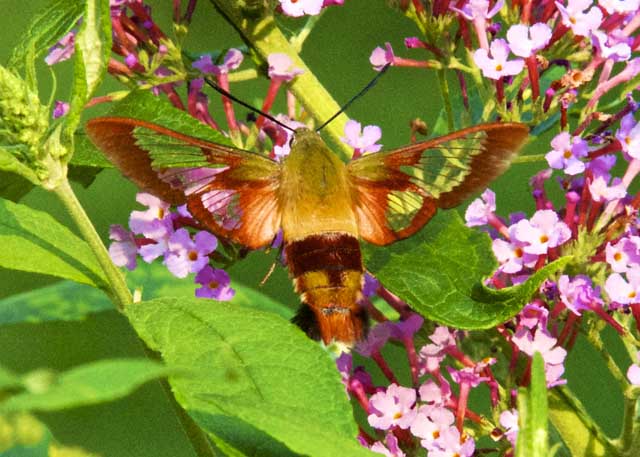Sphinginae subfamily
Sphingini tribe:
 |
Agrius cingulata WO stray:
This species is not reported in Middlesex County but may occur as a
stray from much further south. The moth is a very strong flier and is frequently
encountered far north of its usual range.
|
 |
Ceratomia amyntor BAMONA,
the Elm Sphinx or Four-horned Sphinx: This moth is now officially recorded in Middlesex; it
has been taken in eastern Maine and eastern New Hampshire and in much of Connecticut.
Larvae feed on Elm (Ulmus), birch (Betula), basswood (Tilia), and cherry (Prunus).
|
 |
Ceratomia catalpae WO, Catalpa Sphinx:
This is generally a more southerly species, but it has been recorded in northwards of Middlesex County.
I saw them in great numbers in New Jersey. The larvae feed in large groups and are much more
spectacular than the moths.
Catalpa is the larval host.
|
 |
Ceratomia undulosa BAMONA, Waved Sphinx:
This moth is recorded in Middlesex,
and has been observed to the north, west and south.
It is named for the wavy lines on the forewings.
|
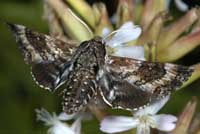 |
Dolba hyloeus WO, Pawpaw Sphinx:
This moth is not officially recorded in Middlesex, but
it has been taken to the north, west and south. Larve are not limited to pawpaw.
|
 |
Lapara bombycoides BAMONA,
Northern Pine Sphinx: Reported from Middlesex, it is widely reported in Massachusetts and along the coast in New Hamshire and
Vermont. This is another one we have on P.E.I.
|
 |
Lapara coniferarum
BAMONA, Southern Pine Sphinx: Widely reported in Massachusetts and along the coast in New Hamshire and Vermont.
If you've got pines, this species is likely present. |
 | This species is probably present in Worcester County. The upperside of the forewing is gray-brown with wavy lines, black
dashes, and one or two small white spots near the center of the costa.
|
 |
Manduca quinquemaculatus, BAMONA, Five-spotted Hawkmoth:
This species is now officially recorded in Middlesex; if you grow tomatoes, you have likely encountered it.
|
 |
Manduca sexta, BAMONA, Carolina Sphinx:
If you grow tomatoes, you have probably encountered it.
Larvae get very large and can strip a tomato plant. |
 |
Sphinx chersis, BAMONA, Northern Ash Sphinx; Great Ash Sphinx:
This species is probably still present but may not be common. Larval hosts are ash, lilac, privet, cherry, and quaking aspen.
|
 | This species is probably present, but has not been officially reported. We have them on
P.E.I., but I do not see them nearly as frequently as I see the other Sphingidae. |
 | This species is probably present in Middlesex County. Colouration and markings are highly variable from one specimen to
another. The fringes on forewing are mostly black with some white; those on the hindwing are mostly white with a
few black patches. |
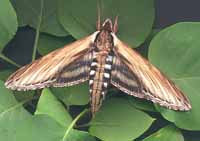 |
Sphinx kalmiae WO, Laurel Sphinx:
This species is not officially reported in Middlesex, but should be present.
I have taken them on P.E.I., Canada, and reared them on
lilac. At rest the hindwings are usually completely covered.
|
 |
Sphinx luscitiosa BAMONA, the Canadian Sphinx or Clemen's Sphinx:
This one is reported from Middlesex, and it flies to the south and west in Massachusetts
and can be fairly common in New Hampshire and Maine. |
 |
Sphinx poecila BAMONA, Poecila Sphinx:
If you have blueberries in the woods, then you probably have the Poecila Sphinx.
They are pretty common here on Prince Edward Island, but don't fly
too far south of Massachusetts, being replaced by Sphinx gordius
in Connecticut. |
Smerinthini Tribe:
 |
Amorpha juglandis WO,
the Walnut Sphinx:
This moth is also fairly widely reported to the north, west and south
of Middlesex.
This is the first Sphinx species I reared as a boy in New Jersey.
Female is different. |
 |
Pachysphinx modesta WO, the Modest Sphinx or Poplar Sphinx:
This moth is found to the north, west and south of Middlesex so it is
probably present there too.
They are common on Prince Edward Island. |
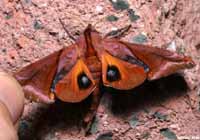 |
Paonias astylus WO, Huckleberry Sphinx:
This moth would likely be rare in Middlesex, but may be present. It would be more common
in southern Massachusetts and is a relatively uncommon species.
Only rarely are they seen in Maine. I never saw one in New Jersey.
|
 |
Paonias excaecata BAMONA/DK, Blinded Sphinx:
Named for the dull grey-blue spot in the hindwing, this moth has a wide distribution and is probably common in Middlesex
I regularly see them on Prince Edward Island, and they are reported
as far south as Florida. |
Paonias excaecata, July 30, 2014, Debra
 |
Paonias myops BAMONA, Small-eyed Sphinx:
Named for the small eye-spot in the hindwing, this moth has a wide distribution and is probably common in Middlesex.
I regularly see them on Prince Edward Island, and they are reported as far south as Florida. |
 |
Smerinthus jamaicensis
BAMONA, Twin-spotted Sphinx:
This moth is widely distributed and fairly common so I suspect it is
in Middlesex. Along the East Coast, it flies from P.E.I. to Florida. |
Macroglossinae subfamily
Dilophonotini tribe:
See Hemaris comparison to help distinguish the next three species.
 |
Hemaris thysbe AM/ BAMONA/FV, Hummingbird Clearwing:
This interesting day flier is confirmed for Middlesex (7-24-94 AM). They are widely distributed in the east from P.E.I. to Florida. |
Hemaris thysbe, Wilmington, July 27, 2014, courtesy of Frank Vento.
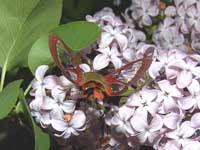 |
Hemaris gracilis
BAMONA,
The Slender Clearwing or Graceful Clearwing:
This day flier is not commonly reported, but is present in Middlesex (7-24-94).
|
 |
Hemaris diffinis
AM/ BAMONA, Snowberry Clearwing; Bumblebee Moth:
This moth is widely distributed and often reported north, west and south of Middlesex as well as in that county.
|
Philampelini tribe:
 |
This moth is not officially reported for Middlesex, but it is fairly often reported
along the coast from southern New Jersey
to central Maine. Note the differences between this moth and the Pandorus Sphinx. |
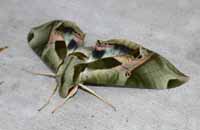 |
Eumorpha pandorus DK/ BAMONA, Pandorus Sphinx:
If you have Grape or Virginia Creeper nearby, then you probably have this species. I often get asked to identify larvae from areas where
they have not previously been reported. |
Eumorpha pandorus, July 27, 2014, Debra
Macroglossini tribe:
 |
Amphion floridensis AM/ USGS, Nessus
Sphinix: This day flier is widely distributed. If you have Virginia Creeper, you
probably have the Nessus Sphinx. Two bright, distinct, narrow yellow bands are often visible on the abdomen. |
 |
Darapsa choerilus MDA, Azalea Sphinx:
They are common in New Jersey and common here on Prince Edward Island.You will often see this species listed as Darapsa pholus,
especially in older literature. Matthew reports it in June-July in Boxford |
 |
Darapsa myron MDA, Virginia Creeper Sphinx; Grapevine Sphinx:
This moth is recorded on the U.S.G.S. site for Essex County (Boxford, July).
It is widely reported as far north as southern Maine. If you have the foodplants
indicated in the common names, you probably have this species nearby. |
 |
Darapsa versicolor MDA, Hydrangea Sphinx:
If you have hydrangea growing near a stream, then you may have the Hydrnagea Sphinx. It has not been widely reported (Boxford: July 29, 1984), however, and
probably is uncommon. |
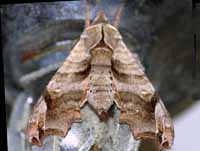 |
Deidamia inscriptum MDA, Lettered Sphinx:
This species has been recorded in western Massachusetts and just south of Essex so it is not surprising to find Matthew's sighting in Boxford, May 16, 1997.
It is generally absent to the north so would be uncommon. |
 |
Hyles gallii MDA, Bedstraw Hawk Moth or Gallium Sphinx:
This species is reported in Topsfield and Boxford in June. Maureen Cauvel found a larva, October 6 in Ashby.
Some years I see them on P.E.I., some years, I do not.
|
 |
Hyles lineata MDA, White-lined Sphinx:
This species is reported from Essex County (May 17, 1999).
It is a strong migrator from the south,
and there are records from the west and to the north. |
 |
Sphecodina abbottii MDA, the Abbott's Sphinx:
This moth is very much under reported (Boxford, Topsfield, Danvers; May-June). It is a
rapid day flier so is probably not in too many collections. Grape is a popular larval host.
|
Sphecodina abbottii: Madeline Champagne reports sighting of two mature larvae, July 6, 2007 in Sherborn.
|
|


